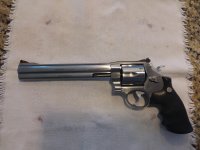A tight Barrel/cylinder gap, in my opinion, is important as it is one of many check points indicative of high quality fitting.
If S&W is now OK with a .012" B/C gap what else are they letting slide? Of course, if they can't even get barrels fitted straight with the frame, maybe they need a .012" B/C gap! (So much for the "perfection" of CNC machining, at least when it's used as a substitute for quality control!)
There should be no binding issues resulting from a tight B/C gap even with soft lead or cast bullets. If so, then there may be other problems involving chamber to bore alignment, forcing cone taper, timing, crane alignment, etc.
Here's a simple quick check.
Look at your fired cartridges: are the firing pin indentations in the primers centered, or are they slightly off to the left or right?
Not the most precise way to measure cylinder alignment, but if you have a problem with off-center primer strikes you should have your revolver checked.



